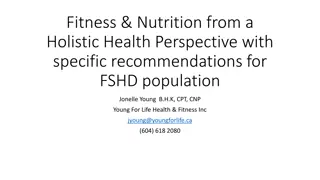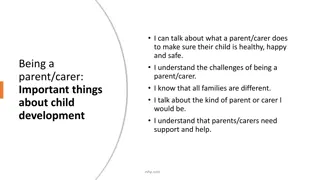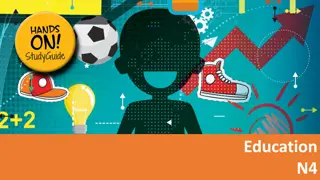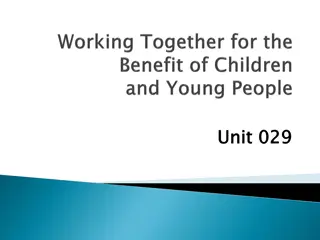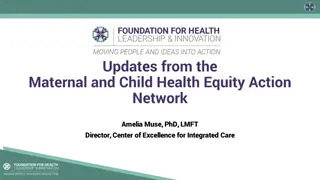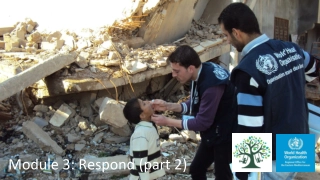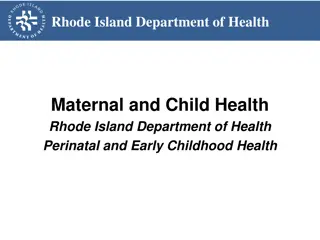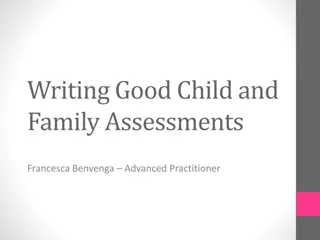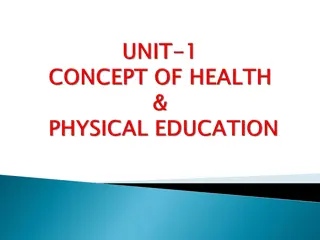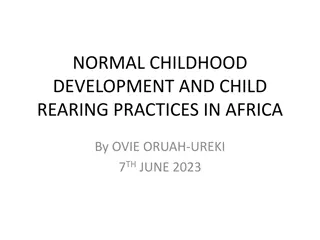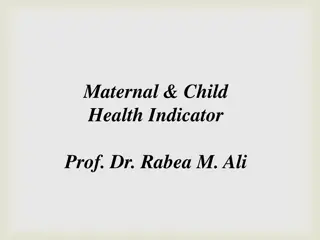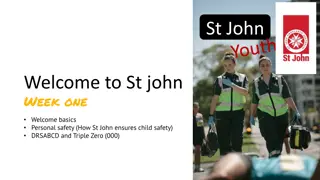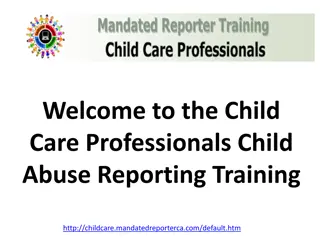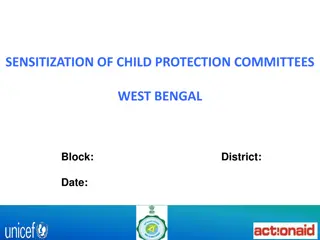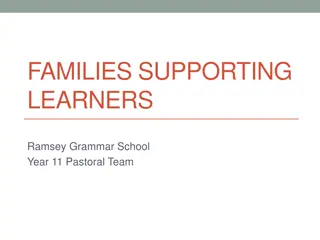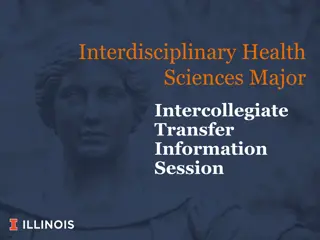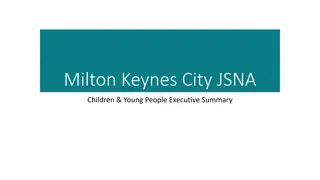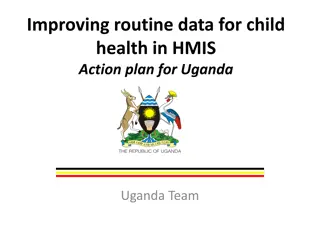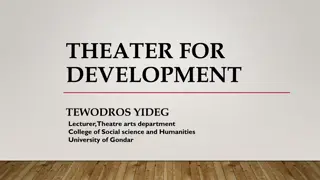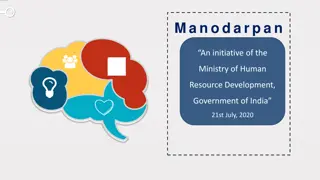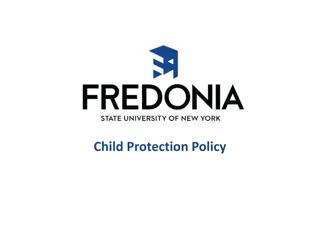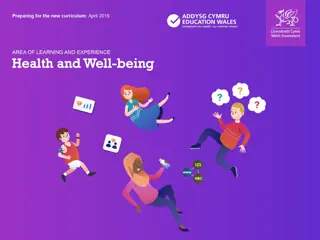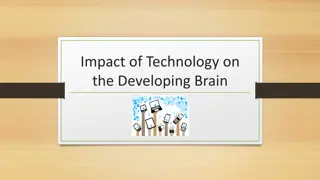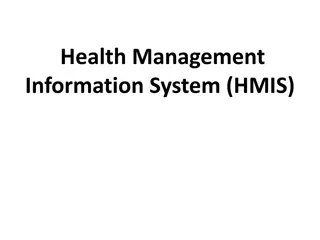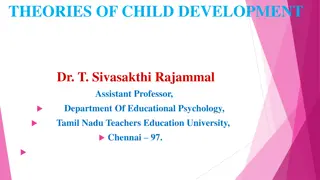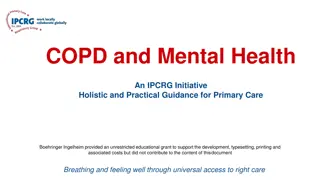Understanding Child Health and Holistic Development
The modules explore the concept of health for young children, defining it as a state of complete physical, mental, and social well-being. It delves into the characteristics of a healthy child, factors influencing health, holistic development, and the team approach to child health involving various professionals. The content emphasizes the importance of a balanced approach to ensure a child's overall well-being, highlighting the influence of heredity, behavior, choices, and environment.
Download Presentation

Please find below an Image/Link to download the presentation.
The content on the website is provided AS IS for your information and personal use only. It may not be sold, licensed, or shared on other websites without obtaining consent from the author. Download presentation by click this link. If you encounter any issues during the download, it is possible that the publisher has removed the file from their server.
E N D
Presentation Transcript
Child Health N4
Module 1 The health of a young child WHAT IS HEALTH? The World Health Organization (WHO) defines health as: A state of complete physical, mental and social well-being, and not merely the absence of disease or infirmity. www.futuremanagers.com
Module 1 The health of a young child (continued) CHARACTERISTICS OF A HEALTHY CHILD Strong bones and teeth; White and healthy teeth; Eager to participate; Shiny hair; Nails are pink and do not Eats well; No visible swelling; break easily; Sleeps well; Normal skin colour; Soft abdomen and normal Body mass is within No dark circles under stools; normal range. eyes; Able to pay attention and Moist and pink mucous learn; membranes; Wide awake and alert; www.futuremanagers.com
Module 1 The health of a young child (continued) FACTORS INFLUENCING HEALTH Several factors influence the health of a child these can start playing a role when the child is still in the womb. These factors can be divided into three basic groups: Heredity; Behaviour and choices; and Environment. www.futuremanagers.com
Module 1 The health of a young child (continued) HOLISTIC DEVELOPMENT AND THE INFLUENCE OF HEALTH Holistic development means the development of the child as a whole. All these aspects work together and should be in balance to make sure the child develops as a whole person. A problem in one area of development will often influence other areas of development as well. www.futuremanagers.com
Module 1 The health of a young child (continued) A TEAM APPROACH TO CHILD HEALTH There is a structure of people who want to ensure that children are kept healthy, including the following: Doctor; Municipality; Dentist; School health services; Occupational therapist; Hospitals; Physiotherapist; Parents/primary caregiver; and Social worker; Educarer. www.futuremanagers.com
Module 1 The health of a young child (continued) COMMUNITY AND ENVIRONMENT HEALTH The term community health refers to the health status of a defined group of people, or community, and the actions and conditions that protect and improve the health of the community. The environment is the area around a person. This includes the: Physical environment; Social and political environment; and Emotional environment. www.futuremanagers.com
Module 1 The health of a young child (continued) SPREADING AND PREVENTION OF DISEASE Diseases can be spread through droplets in the air, contaminated water, direct contact, animals and insects, food and milk, contaminated objects, and contact with body secretion. The educarer can prevent diseases by keeping areas clean, disinfecting toys and surfaces, and educating parents and children about health issues. www.futuremanagers.com
Module 1 The health of a young child (continued) HEALTH PROBLEMS General health problems seen include but are not limited to: Bronchitis; Coughing; Colds; Ear infections; Fever and flu; and Headaches. www.futuremanagers.com
Module 2 Physical aspects of the young child THE SKELETAL SYSTEM The human body has a skeleton that is made up of 206 bones of different shapes and sizes. The bones are important to support the soft tissue and organs inside the body as well as to determine the shape of the body. www.futuremanagers.com
Module 2 Physical aspects of the young child (continued) JOINTS AND MUSCLES A joint is formed where two or more bones get together and are joined by means of ligaments or cartilage. There are three types of joints each with specific functions: Immovable joints such as in the skull; Semi-movable joints such as in the spine; and Movable joint such as the hip, shoulder and wrist. www.futuremanagers.com
Module 2 Physical aspects of the young child (continued) THE NERVOUS SYSTEM This is the system which regulates all the body s reactions to stimuli internally and within the environment. The nervous system is a complex network of nerves and cells that carry messages to and from the brain and spinal cord to various parts of the body. The nervous system can be divided into two sections: Central nervous system; and Peripheral nervous system. www.futuremanagers.com
Module 2 Physical aspects of the young child (continued) THE RESPIRATORY SYSTEM This is the system that helps us to inhale and exhale. The primary function is to supply the blood with oxygen in order for the blood to deliver oxygen to all parts of the body. When we breathe, we inhale oxygen and exhale carbon dioxide. This exchange of gases is the respiratory system s means of getting oxygen to the blood. www.futuremanagers.com
Module 2 Physical aspects of the young child (continued) THE CIRCULATORY SYSTEM The structures of the circulatory system include: The heart; and The blood vessels: Arteries take blood from heart to the body; Veins take blood to the heart; and Capillaries connect arteries and veins. www.futuremanagers.com
Module 2 Physical aspects of the young child (continued) THE DIGESTIVE SYSTEM The structure of the digestive system is as follows: The mouth; The small intestines; The pharynx; The large intestines; The oesophagus The liver; (gullet); The gall bladder; and The stomach; The pancreas. www.futuremanagers.com
Module 2 Physical aspects of the young child (continued) URINARY/EXCRETORY SYSTEMS There are a number of structures forming part of the urinary system, namely: Kidneys; Ureters; Bladder; and The urethra. www.futuremanagers.com
Module 2 Physical aspects of the young child (continued) THE SENSORY ORGANS Visual: The eyes are the organs of sight. Auditory: The ears are the organs of hearing. Tactile: The skin is the organ of touch. Gustatory: The tongue is the organ of taste. Olfactory: The nose is the organ of smell. www.futuremanagers.com
Module 2 Physical aspects of the young child (continued) THE REPRODUCTIVE SYSTEMS In the human reproductive process, two kinds of sex cells, or gametes, are involved. The male gamete, or sperm, and the female gamete, the egg or ovum, meet in the female s reproductive system to create a new individual. www.futuremanagers.com
Module 2 Physical aspects of the young child (continued) PRE-NATAL CARE It is important for the pregnant mother to follow a healthy and balanced diet as this will have a positive effect on the development and health of her unborn baby. A pregnant mother should take care of her personal welfare such as paying attention to her skincare, hair, teeth, legs, feet, abdomen and breasts. She should also get enough rest to keep energy levels up. www.futuremanagers.com
Module 2 Physical aspects of the young child (continued) THE PROCESS OF GIVING BIRTH - LABOUR Normal pregnancy lasts 40 weeks. At around 36 weeks, the baby usually gets into the final position for birth. Labour is divided into three stages: Stage 1 is the onset of labour and starts when the cervix and uterus undergo changes to show the baby is on his way. Stage 2 is the real birth of the baby. Stage 3 is the delivery of the placenta or afterbirth. www.futuremanagers.com
Module 3 Nutrition BREASTFEEDING Breast milk is the best choice for the new-born baby. It is the perfect first food and the mother should try her best to feed the baby herself if possible. Babies only need breast milk for the first few months of their lives. www.futuremanagers.com
Module 3 Nutrition (continued) BOTTLE-FEEDING/ARTIFICIAL FEEDING Milk is the primary food for the baby for the first year of his life. If breastfeeding is not possible, the mother will get help and advice from the clinic to choose the most suitable product for the specific needs of her baby. There are three different types of formula: Cow s milk-based formula; Hydrolysed protein formula; and Soya-based formula.. www.futuremanagers.com
Module 3 Nutrition (continued) WEANING FROM THE BREAST TO THE BOTTLE This is the process of gradually introducing bottle-feeds to a breastfed baby. It also means the process of changing the baby from milk only to solid foods and milk. Both these are gradual processes and should be handled carefully to ensure success. www.futuremanagers.com
Module 3 Nutrition (continued) INTRODUCTION TO SOLID FOOD From four to six months, most babies are ready to be introduced to solid foods. The first foods should be very well pureed and there should not be any lumps or coarse bits. www.futuremanagers.com
Module 3 Nutrition (continued) NUTRITIONAL PROBLEMS Symptoms of possible feeding problems from: Birth to two years include: Restlessness; poor sleeping pattern; and crying during and after feeding. Young children 2 6 years include: Hunger; overeating; and no no energy. www.futuremanagers.com
Module 4 Care of the young child HANDLING THE BABY At first, new parents may be scared to handle the young baby. It is good to know that normal babies can be handled without fear. The adult should ensure that the handling is in a gentle way and must always keep safety in mind. The main ways of holding a baby are: To the shoulder; Cradled in the arms; and Held in one arm. www.futuremanagers.com
Module 4 Care of the young child (continued) WASHING THE BABY Most healthy babies will have a bath once a day and a body wash once a day. This process of washing is called top-and-tailing as the emphasis is on the baby s face and bottom. When bathing the baby, make sure the bath is on a sturdy surface, the nappy should be folded ahead of time, and test the water temperature with your elbow before. www.futuremanagers.com
Module 4 Care of the young child (continued) NAPPIES There are three different types of nappies available: Towelling; Flannel; and Disposable. www.futuremanagers.com
Module 4 Care of the young child (continued) THE BABY S LAYETTE (FIRST SET OF CLOTHING AND EQUIPMENT) Basic items needed for the layette: Nappies; Mittens; Suits or dresses; Waterproofs; Cot sheets; Soap; and Bibs; Towels; Shampoo. Hoods; Blankets; Baby grows; Pairs of booties; www.futuremanagers.com




